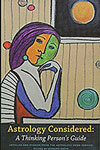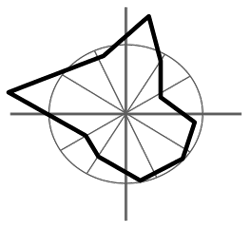Psychology professor finds ingenious way to test controversial astrological assumptions
When in the last century French statistician Michael Gauquelin published the results of his ground-breaking statistical studies examining some basic tenets of astrology response from the academic community was anything but kind.
Gauquelin’s work extended over a period of 23 years between 1949 and 1973. In a series of studies he statistically tested how the planets influenced everything from character traits to heredity, athletic prowess and the career paths taken by professionals who are eminent in their fields. Mostly, it was the studies dealing with eminent professionals and elite athletes that created such a ruckus in the scientific community.
Initially, in a study involving 508 births, Gauquelin impressively demonstrated a correlation of Mars and Saturn with physicians at a chance level in the millions to one range. Simply, in the birth charts of prominent physicians, Saturn or Mars were either rising or culminating in so-called Gauquelin “plus zones” with a significantly greater frequency than expected by chance.
One of the Gauquelin plus zones straddles what astrologers call the ascendant or rising sign on the birth chart’s eastern horizon. Another hugs what astronomers call the meridian plane and astrologers refer to as the midheaven. Traditionally, planets posited near these “angles” in a birth chart are believed to express their influence more powerfully in the individual’s life. Gauquelin had similar success correlating other professions with the planets traditionally identified with them. For example, Mars turned up in the plus zones for elite athletes, Saturn was there for scientists, the Moon for writers and Jupiter for actors and politicians. The significance level for some of these correlations was also in the millions to one chance level. However, this result applied only to eminent professionals and elite athletes and was not present in the birth charts of ordinary athletes or professionals who were not eminent in their fields, which gave critics some contentious talking points.
Canines to the Rescue
Michael Gauquelin is not the only researcher to demonstrate that planets rising on the Eastern horizon or culminating near the midheaven are more influential. A novel study by another French scientist, the late Prof. Suzel Fuzeau-Braesch of Paris University, sought to determine whether the behavior of 500 pedigreed puppies from 100 different litters would measurably correlate to rising or culminating planets in their birth charts. She was advised in this unique project by Michael’s wife, Francoise Gauquelin, a statistician who also was closely involved with her husband in his work.
The whelping of a litter of puppies can extend over a period of several hours with as little as 15 minutes – or as much as two hours – between births. So birth charts lay out differently for every pup in a litter. The pups were closely monitored through the first eight weeks of life, but the hypothesized results were apparent almost immediately. Prof. Fuzeau-Braesch discovered that the dominant pups – the more aggressive, assertive, tail-wagging leaders of every group – had either the Sun or Jupiter rising or culminating in their birth charts with a frequency that far exceeded the threshold of significance established for the test.
Depending upon whatever else is going on in the heavens at the time, astrologers might describe humans with these same prominent planetary placements as charismatic, dominant, strong, sociable or influential. And psychologists might use the term extrovert when labeling these same essentially positive, outgoing personality traits. At Johnson State College in Vermont, Psychology and Counseling Professor David Fink studied the Gauquelin results and came up with an ingenious way to test whether planets in the plus zones could predict introversion-extraversion behavioral traits as measured by the Eysenck Personality Inventory (EPI) questionnaire.
Prof. Fink directs Johnson State College’s master’s program in counseling. He first encountered Gauquelin’s research in the 1980s and describes his interest in the statistician’s work in this way:
“My field is the training of counselors and psychotherapists. We are vitally interested in any tool that helps us understand people and the challenging issues that bring them to seek help in therapy. The Gauquelin research stimulated my interest in examining whether the astrological birth chart might prove useful as an empirically defensible tool for assessing personality dimensions.”
A More Promising Approach
Rather than testing the birth data of eminent professionals, Prof. Fink found a more promising – and less controversial – way to test the Gauquelin plus zones. Over a period of 15 years he administered EPI tests to 932 college students at three universities: Johnson State, the University of Vermont and the University of Maine. He was especially interested in the EPI test’s “E” scale, which is a measure of introversion-extraversion. A high score on the “E” scale equates to extraversion and a low score to introversion.
Astrologers associate the planet Jupiter with expansive, outgoing personality traits and Saturn with caution and reserve. Prof. Fink hypothesized that individuals with Jupiter in one of the plus zones identified by Gauquelin should test higher on the “E” scale while those with Saturn in these locations should test lower.
To analyze the collected data he reached out to astrological researcher David Cochrane, who at the time was enrolled in graduate classes in research methodology and statistics at the University of Florida. Cochrane is a past president of the International Society for Astrological Research (ISAR) and is Chairman and founder of the Cosmic Patterns astrological software company. At Florida University he got approval from the head of the Research and Evaluation Methodology Department to do the analysis as partial fulfillment for a three-credit independent study course. A professor in the Sociology Department, Monika Ardelt, mentored the project, providing “important suggestions that improved analysis of the results,” he said.
A Statistically Significant Result
“Statistical significance is the gold standard for an experimental design that evaluates whether a hypothesis is true or not. A result is generally regarded as being statistically significant if the probability of obtaining it is less than 5 percent, or what researchers call a p value of .05. Researchers should collect enough data to potentially obtain this level of significance,” Cochrane explained.
He points out that the placement of Jupiter or Saturn in one of the plus zones is only one variable among a great many possible astrological variables that might affect the “E” score. Also, non-astrological factors like genetics and the environment may factor into the outcome as well. With 982 cases, the researchers wanted to determine whether the effect of a single variable could be detected. It was.
“The result for this data analysis, which is known in statistics as a 2-tailed t-test, was significant at the .05 p value level. In a more sophisticated test that included age as a predictor of the E score the result was even better with a 2 percent probability. Effectively, the hypothesis was clearly stated and was confirmed by the result. Because the students did not know how Prof. Fink would analyze the data at the time they were tested there was no way for their test scores to have been influenced by the hypothesis tested,” he added.
According to Prof. Fink, if results of the research eventually are replicated in future studies with a similar design the significance will be twofold. For one thing, it will present to scientists in other fields suggestive evidence of the birth chart’s validity that will be difficult to dismiss out of hand without further serious investigation. Also, it will provide practicing astrologers with more precise guidelines for interpreting the strength of angular planets located in the Gauquelin plus zones.
Prof. Fink says his primary interest in the subject revolves around approaching astrology “as an alternative language system that can help clinicians assess and conceptualize their clients with different terminology, and also communicate with clients in vocabulary that is less stigmatizing to them than the psychopathologizing categories we traditionally employ in the mental health field.
“I speak to my students about the study after first describing to them the ground breaking work of the Gauquelins, and the reluctance of most empirical scientists to engage with the Gauquelin results. Students are generally fascinated with the work, but at the same time are somewhat daunted by the statistical and methodological issues that inevitably must be addressed,” he noted.
This article originally published by Astrology News Service, reprinted here with their kind permission.

Author: Edward Snow
Edward Snow is the Managing Editor of the Astrology News Service (ANS). He is a former news reporter and publicist who has managed PR programs for national and regional clients. Snow is the editor of Astrology Considered: A Thinking Person's Guide (left) which lists articles and stories from the Astrology News Service.



